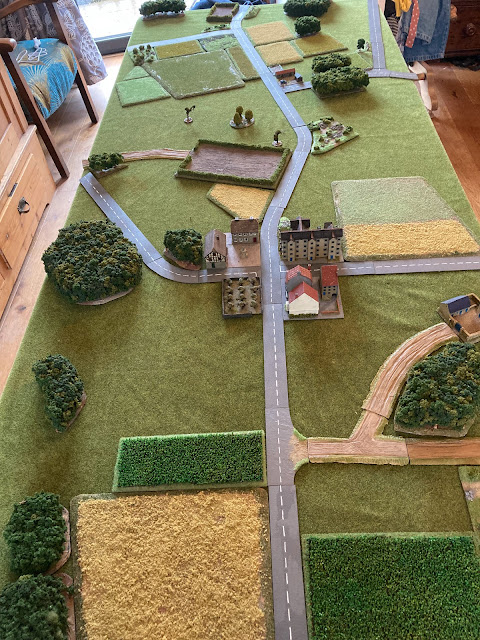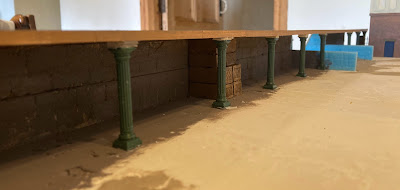Inspired by Al Sheward's brilliant Oosterbeek terrain at Ebor Lard, I've been thinking about how I might apply some of the techniques in 6mm scale.
Al's terrain consisted of modules (e.g. a building surrounded by gardens and outhouses on a single base) that could be placed side-by-side to fill the area of the table. There are advantages to this including storage and flexibility. A terrain module that fits exactly into the space at the corner of Utrechteseweg and Stationsweg will also work perfectly well in some alternative fictional setting.
One way to have modules that fit together is to give them all right-angle corners. This is something that Richard Phillips has done to great effect in his terrain for the Cold War Commanders games at various shows.
I've done something vaguely similar with some fields I've produced recently.
Because I want to use them for Germany and Czechoslovakia, I've eschewed the use of hedges, the field boards just have chamfered edges covered in a contrast colour of flock/static grass mix.
I then wondered if there was some mileage in producing small modules specifically designed to slot together but more irregular in shape. Using a few offcuts of PVC board I've knocked up these over the last few days.
The oddly-shaped road junction was a piece I'd made from a left-over scrap of cheap vinyl floor tile; my go-to material for 6mm tarmac roads. I cut a piece of PVC board to slot up against its wavy edge. I chamfered all the edges of the small field, coated it with quick-drying Polyfilla, and stuck in some bits of cat litter along the roadside edge to represent stones moved from the field by the farmer.
I then realised that a straight road piece attached to the junction would create an inconveniently shaped triangular space so I quickly made a small grassy extension to the field. With a bit of clump foliage to hide the join, I think the effect's OK. I'll do some more of this sort of thing.
The use of clump foliage to hide joins is important, I think. In the pics below are a couple of areas of broken round I've made from recycled bases of old forest pieces.
I've now got plenty of terrain for at least one Prague Summer 1948 table. Just another five to do!





























